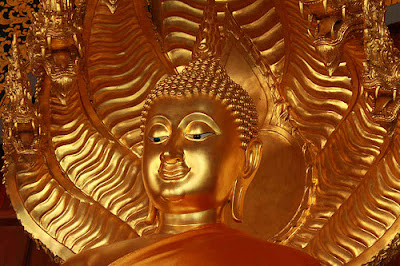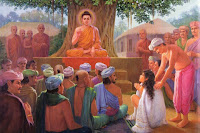Dhr. Seven, Ven. Karunanada, Vesak 2013, Wisdom Quarterly; Merriam-Websters.com
 |
| The Buddha with bright gold complexion guarded by seven nagas (Hanuman/flickr.com) |
 |
| Buddha's eyes of wisdom, Nepal |
Ascetic (shraman) Siddhartha awoke from the illusion, found enlightenment, and became an “awakened one” (Sanskrit, buddha). Buddha is only a title -- one of many -- not a name. Buddhists
believe that there are were at least 24 buddhas in the past aeon, and there may eventually be others in the distant future IF bodhisattvas (“buddhas-to-be”)
practice. There is little guarantee that they will, just a likelihood,
and even less certainty that they will rediscover the liberating Truth
any time soon. It is likely to be ages and aeons rather than millennia
and epochs.
 |
| The Buddha teaching in ancient India |
At that time the area was a rich crossroads between East and West, much as prehistoric Kusinara had been when he chose that former kingdom (DN 16, Part 5, Section 41-44) to pass into final-nirvana in spite of Ananda's objections:
 |
| Under a sprawling Bo tree (Earth-spirit/flickr) |
He is said to have lived a sheltered life of luxury that was
interrupted when he left the palace and encountered four signs [possibly arranged by devas for maximum impact] an old person, a sick one, a corpse, and a renunciant wandering ascetic.
Renouncing his princely life, he spent six years
seeking out a meditation teacher and attempting to master various ascetic practices to develop serenity and samadhi (super-consciousness, concentration, collected mind).
Other practices included futile fasting and severe asceticism in a vain effort to win enlightenment, liberation from all suffering, referred to as moksha in ancient Indian circles. Dissatisfied with the results, he reverted to caring for his body, resting, eating, and cultivating the meditative-absorptions (jhanas).
Enlightenment and Nirvana
He did this while meditating beneath the Bodhi tree, Ficus religiosa, where after being tempted and tormented by Mara, he pursued the question: "What is the cause of present suffering in the present?" In answering, he traced back the 12 links of Dependent Origination and realized the Four Noble Truths.
This methodical mindful practice of liberating-insight cultivated on the stable foundation of "right concentration" (samma-samadhi) after emerging from absorption, he was able to achieve enlightenment. Luxury and laxity had not accomplished it. Struggle and effort had not accomplished it. But the Middle Way, avoiding extremes of hedonism and self-mortification, led to equanimous heart and a balanced mind able to breakthrough to the ultimate Truth. And the Truth sets one free.
At Sarnath he preached his first sermon to former his ascetic companions, turning the "Wheel of the Dharma," outlining the ennobling Eightfold Path, which offered a Middle Way between self-indulgence and self-mortification and led to real moksha beyond heavenly rebirths, which is the liberation of nirvana.
The five ascetics who heard this sermon became not only his first disciples but also arhats, fully enlightened individuals, who glimpsed and touched nirvana and would find release from all rebirth and suffering after passing away. With his mission fulfilled, the Buddha also passed into the bliss of final-nirvana after eating a meal that may accidentally have contained deadly mushrooms and escaped the cycle of rebirth. His body was cremated, and his relics and ashes were interred in stupas.
 |
| (VagabondTravels/flickr) |
Other practices included futile fasting and severe asceticism in a vain effort to win enlightenment, liberation from all suffering, referred to as moksha in ancient Indian circles. Dissatisfied with the results, he reverted to caring for his body, resting, eating, and cultivating the meditative-absorptions (jhanas).
Enlightenment and Nirvana
 |
| Reclining into final peace, pari-nirvana (E-S) |
This methodical mindful practice of liberating-insight cultivated on the stable foundation of "right concentration" (samma-samadhi) after emerging from absorption, he was able to achieve enlightenment. Luxury and laxity had not accomplished it. Struggle and effort had not accomplished it. But the Middle Way, avoiding extremes of hedonism and self-mortification, led to equanimous heart and a balanced mind able to breakthrough to the ultimate Truth. And the Truth sets one free.
 |
| Vesak arrives on the full-moon day of the Indian month of Vesakha (lunaf.com). |
At Sarnath he preached his first sermon to former his ascetic companions, turning the "Wheel of the Dharma," outlining the ennobling Eightfold Path, which offered a Middle Way between self-indulgence and self-mortification and led to real moksha beyond heavenly rebirths, which is the liberation of nirvana.
The five ascetics who heard this sermon became not only his first disciples but also arhats, fully enlightened individuals, who glimpsed and touched nirvana and would find release from all rebirth and suffering after passing away. With his mission fulfilled, the Buddha also passed into the bliss of final-nirvana after eating a meal that may accidentally have contained deadly mushrooms and escaped the cycle of rebirth. His body was cremated, and his relics and ashes were interred in stupas.
 |
| Buddha on pyramid pillow reclining into final nirvana (Hereward J Bunch/hezbunch/flickr) |
































































































































































































































No comments:
Post a Comment